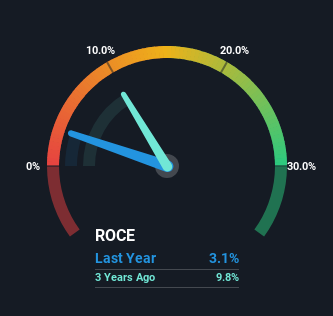- United States
- /
- Commercial Services
- /
- NasdaqGM:QH
Investors Will Want Quhuo's (NASDAQ:QH) Growth In ROCE To Persist

There are a few key trends to look for if we want to identify the next multi-bagger. Firstly, we'd want to identify a growing return on capital employed (ROCE) and then alongside that, an ever-increasing base of capital employed. Put simply, these types of businesses are compounding machines, meaning they are continually reinvesting their earnings at ever-higher rates of return. So when we looked at Quhuo (NASDAQ:QH) and its trend of ROCE, we really liked what we saw.
What Is Return On Capital Employed (ROCE)?
For those that aren't sure what ROCE is, it measures the amount of pre-tax profits a company can generate from the capital employed in its business. The formula for this calculation on Quhuo is:
Return on Capital Employed = Earnings Before Interest and Tax (EBIT) ÷ (Total Assets - Current Liabilities)
0.031 = CN¥18m ÷ (CN¥1.1b - CN¥515m) (Based on the trailing twelve months to June 2023).
So, Quhuo has an ROCE of 3.1%. In absolute terms, that's a low return and it also under-performs the Commercial Services industry average of 8.9%.
Check out our latest analysis for Quhuo

Historical performance is a great place to start when researching a stock so above you can see the gauge for Quhuo's ROCE against it's prior returns. If you'd like to look at how Quhuo has performed in the past in other metrics, you can view this free graph of past earnings, revenue and cash flow.
How Are Returns Trending?
The fact that Quhuo is now generating some pre-tax profits from its prior investments is very encouraging. The company was generating losses five years ago, but now it's earning 3.1% which is a sight for sore eyes. And unsurprisingly, like most companies trying to break into the black, Quhuo is utilizing 221% more capital than it was five years ago. This can indicate that there's plenty of opportunities to invest capital internally and at ever higher rates, both common traits of a multi-bagger.
Another thing to note, Quhuo has a high ratio of current liabilities to total assets of 47%. This effectively means that suppliers (or short-term creditors) are funding a large portion of the business, so just be aware that this can introduce some elements of risk. Ideally we'd like to see this reduce as that would mean fewer obligations bearing risks.
Our Take On Quhuo's ROCE
To the delight of most shareholders, Quhuo has now broken into profitability. However the stock is down a substantial 98% in the last three years so there could be other areas of the business hurting its prospects. Regardless, we think the underlying fundamentals warrant this stock for further investigation.
Quhuo does come with some risks though, we found 4 warning signs in our investment analysis, and 1 of those doesn't sit too well with us...
If you want to search for solid companies with great earnings, check out this free list of companies with good balance sheets and impressive returns on equity.
Valuation is complex, but we're here to simplify it.
Discover if Quhuo might be undervalued or overvalued with our detailed analysis, featuring fair value estimates, potential risks, dividends, insider trades, and its financial condition.
Access Free AnalysisHave feedback on this article? Concerned about the content? Get in touch with us directly. Alternatively, email editorial-team (at) simplywallst.com.
This article by Simply Wall St is general in nature. We provide commentary based on historical data and analyst forecasts only using an unbiased methodology and our articles are not intended to be financial advice. It does not constitute a recommendation to buy or sell any stock, and does not take account of your objectives, or your financial situation. We aim to bring you long-term focused analysis driven by fundamental data. Note that our analysis may not factor in the latest price-sensitive company announcements or qualitative material. Simply Wall St has no position in any stocks mentioned.
About NasdaqGM:QH
Quhuo
Through its subsidiaries, operates a gig economy platform in the People’s Republic of China.
Adequate balance sheet and slightly overvalued.
Market Insights
Community Narratives



